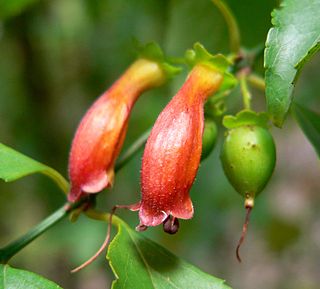
Olea is a genus of about 40 species in the family Oleaceae, native to warm temperate and tropical regions of the Middle East, southern Europe, Africa, southern Asia, and Australasia. They are evergreen trees and shrubs, with small, opposite, entire leaves. The fruit is a drupe. Leaves of Olea contain trichosclereids.

Anthodiscus is a genus of plant in family Caryocaraceae described as a genus in 1818.

Diascia is a genus of around 70 species of herbaceous annual and perennial flowering plants of the family Scrophulariaceae, native to southern Africa, including South Africa, Lesotho and neighbouring areas.
Minuria is a genus of annuals, perennials and dwarf shrubs in the aster tribe within the sunflower family.
Heteromma is a genus of South African flowering plants in the sunflower family.
Heterorhachis is a genus of South African flowering plants in the daisy family.

Halleria is a genus of flowering plants in the family Stilbaceae described as a genus by Linnaeus in 1753.
Gonostemon is a genus of plants in the Apocynaceae, first described as a genus in 1812.
Aspidoglossum is a genus of plants in the family Apocynaceae, first described as a genus in 1838. It is native to Africa.
Anisotoma is a genus of flowering plants formerly belonging to the plant family Asclepiadaceae, now considered to be part of the Apocynaceae, first described as a genus in 1844. They are native to South Africa
- Anisotoma cordifoliaFenzl - South Africa
- Anisotoma pedunculataN.E.Br. - KwaZulu-Natal

Pachycarpus is a genus of plants in the family Apocynaceae, first described in 1838. It is native to Africa.
Parapodium is a genus of flowering plants of the family Apocynaceae, first described as a genus in 1838. It is native to South Africa.
- Parapodium costatumE.Mey. - South Africa
- Parapodium crispumN.E.Br. - South Africa
- Parapodium simileN.E.Br. - South Africa

Pentarrhinum is a genus of plants in the family Apocynaceae, first described as a genus in 1838. It is native to Africa.
- Pentarrhinum abyssinicumDecne. - E + C + S Africa
- Pentarrhinum balense(Liede) Liede - Ethiopia
- Pentarrhinum coriaceumSchltr. - KwaZulu-Natal
- Pentarrhinum gonoloboides(Schltr.) Liede - Tanzania
- Pentarrhinum insipidumE.Mey. - South Africa
- Pentarrhinum ledermannii(Schltr.) Goyder & Liede - Burundi
- Pentarrhinum somaliense(N.E. Br.) Liede - Somalia

Sisyranthus is a group of plants in the family Apocynaceae first described as a genus in 1838. It is native to southern Africa.
Sphaerocodon is a genus of plants in the Apocynaceae first described as a genus in 1876. It is native to southern Africa.
- Sphaerocodon acutifoliumK.Schum. - Namibia
- Sphaerocodon angolensisS.Moore - Angola
- Sphaerocodon caffrum(Meisn.) Schltr. - Tanzania, Malawi, Zambia
- Sphaerocodon melananthum(K.Schum.) N.E.Br. - Zimbabwe
- Sphaerocodon natalenseBenth. - KwaZulu-Natal
- Sphaerocodon obtusifoliumBenth. - South Africa
- Sphaerocodon platypodumK.Schum. - Katanga in southern Zaire
Capelio is a genus of flowering plant in the Asteraceae first described as a genus in 1836 with the name Alciope. It was renamed Capelio in 2002 after it was determined that the name Alciope was not legitimately published according to international nomenclatural rules. Capelio is a taxonomic anagram derived from the former name Alciope.
Ixianthes is a genus of flowering plants in the family Stilbaceae described as a genus in 1836.
Gymnopentzia is a genus of African plants in the chamomile tribe within the sunflower family.
Hypertelis is a genus of flowering plants in the family Molluginaceae. Most of its former species have been transferred to the new genus Kewa, and the remaining species, Hypertelis spergulacea, may also need a different placement. Hypertelis spergulacea is a woody-based plant, up to 30 cm (1 ft) high, with whorled greyish green leaves. It is found on the border between Namibia and the Northern Cape province of South Africa.







